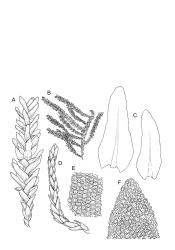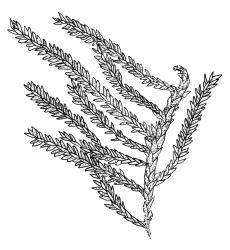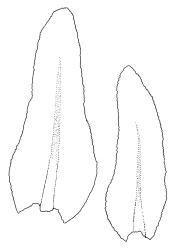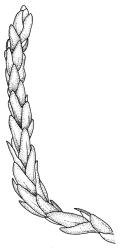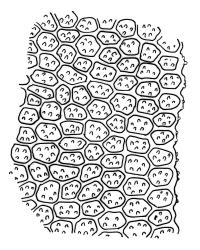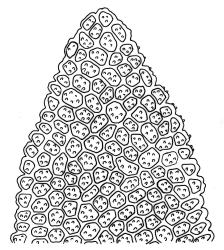- ≡ Hypnum pseudotriste Müll.Hal., Bot. Zeitung (Berlin) 13: 786 (1855)
- ≡ Anomodon pseudotristis (Müll.Hal.) Kindb., Enum. Bryin. Exot. 7 (1888)
- = Anomodon huttonii Mitt., J. Linn. Soc., Bot. 13: 309 (1873)
- ≡ Haplohymenium huttonii (Mitt.) Broth., Nat. Pflanzenfam. [Engler & Prantl] 1(3), 986 (1907)
Plants yellow- or olive-green, creeping, very delicate and filiform. Secondary stems mostly c. 4–7(–15) mm, irregularly branched, in cross-section of incrassate cells nearly throughout, lacking a central strand, with scattered fascicles of smooth, red-brown rhizoids. Stem leaves ovate-lanceolate and acute, c. 0.5 mm, not fragile, crenate. Branches mostly 5–15 mm. Branch leaves lingulate from a ± broadened base or broadly elliptic, rounded, obtuse or broadly acute at apex, (0.40–)0.50–0.58 × 0.15–0.17 mm, crenulate throughout; mid laminal cells rounded-hexagonal, ± obscure in surface view, with several small and rather obscure papillae on each surface, mostly 6–8 µm across, in cross-section bulging and rounded both abaxially and adaxially; juxtacostal cells more elongate in a small area near leaf base. Costa extending c. ⅔ to apex but with the distal half obscure and consisting of non-elongate cells which are scarcely differentiated from adjacent laminal cells, in cross-section bistratose and protruding very weakly on abaxial surface. Paraphyllia lacking. Propagula lacking.
Presumably dioicous. Perichaetia and perigonia not seen. Sporophytes unknown in N.Z. material.
Noguchi 1987–1994, fig. 364, C; Streimann 2002, fig. 66.
Its delicacy and creeping, filiform habit differentiate this relatively rare species from all but a few N.Z. pleurocarps. The leaves of H. pseudotriste are exceedingly small. The cell walls of the bulging and papillose laminal cells are obscure under the microscope. The primary stems are very inconspicuous in N.Z. material but can sometimes be seen adhering to the substrate (as in material from Raoul I., P. de Lange K580, AK 326909).
Haplohymenium pseudotriste could be mistaken for the exceedingly rare Lindbergia maritima, q.v. The present species has leaves of similar size, but differs from the Lindbergia by having a shorter and more obscure costa, several small and rather obscure papillae on each mid to upper laminal cell, broader, more rounded leaf apices, and an absence of axillary propagula.
Pseudoleskea imbricata is another superficially similar species, but it is largely epilithic rather than epiphytic. It is a neater, more julaceous, and somewhat more robust plant in which the costa is better defined and longer and the laminal cells are rounded-rhomboid (rather than rounded-hexagonal).
The very rare Erpodium glaucum is similar in size and overall habit to H. pseudotriste, but is pale green and glaucous in colouration, and has more distinctly ranked and acute to apiculate leaves with no costa. The two species have been collected growing together at the Raukōkore R. in Gisborne L.D.
Thuidium sparsum is generally a bright green plant differing from H. pseudotriste by its decidedly dimorphic leaves (those of stems are ± triangular-ovate), and paraphyllia that are clearly visible under a hand lens.
K; NI: N Auckland, including offshore islands (GB), S Auckland, Gisborne (Raukōkore River), Hawke’s Bay (Wairoa, Māhia Peninsula); SI: Nelson (Kaihokai Lakes, near Tākaka), Westland (Waiho River); Ch.
Anomalous. Mainland Australia (N.S.W.)*, Norfolk I.*. Recorded from numerous Japanese and other East Asian localities, as well as Australia and South Africa, by Noguchi (1987–1994).
Epiphytic on a range of mostly smooth-barked dicotyledonous tree species, including Beilschmiedia tarairi, Coprosma arborea, Corynocarpus laevigatus, Kunzea ericoides, Litsea calicaris, Melicytus ramiflorus, Metrosideros kermadecensis, and Myoporum laetum, as well as Cordyline australis and Rhopalostylis baueri; in lowland and mostly coastal situations. The single confirmed record from the Chatham Is was collected from "the base of an Olearia telmatica tree". Rarely occurring on shaded limestone (as at Waikawau Stream, S Auckland L.D. and at Tākaka, Nelson L.D.). From near sea level to c. 300 m elevation. Frequent associates include Camptochaete pulvinata, Leptodon smithii, Orthorrhynchium elegans, Rhaphidorrhynchium amoenum, and Syrrhopodon armatus, as well as Frullania spp., Metzgeria spp., and various Lejeuneaceae.
The distinctions drawn by Noguchi (1987–1994) between this species and H. triste in Japan are mostly quantitative. The laminal cell dimensions of N.Z. material are intermediate between those given by Noguchi for the two species. The leaves of N.Z. plants are not fragile. Streimann (2002) presented a useful discussion of this species on Norfolk I.; his description of the sporophyte appears not to be based on Australian material.




